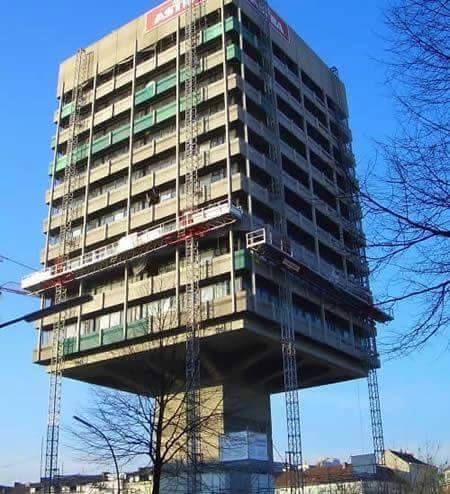Leaderboard
Popular Content
Showing content with the highest reputation on 07/09/17 in all areas
-
Shear wall design
Jairo González reacted to WR1 for a topic
This is absolutely wrong practice. 1. PIERS Assign as per option a (See image posted by sir Makhzumi in previous reply) Why didn't you apply pier to spandrels. Most people do not apply piers labels to spandrels. Give up on that. Lets talk about this image. The top floor. Piers go horizontal with same number. 2 shells of P3, 2 shells of P2 and 2 shells of S1 should all have been defined as one pier. Then P2 and P3 slender piers below them should be assigned different pier names separately. Infact, as flexural deformations are dominant in these slender piers, divide them (mesh) into 4 pieces and assigned different pier to top 2 shells and different to bottom 2 shells (depends on the moment diagram though). 2. SPANDRELS Assign as per option a (See image posted by sir Makhzumi in previous reply) The spandrel I see in image is a deep beam. Isn't it? L/D < 4? If so, where is the meshing? If its not a deep beam then apply different spandrel labels to each shell atleast in the middle for postive moment design.1 point -
Use Of Mass Source Command In Etabs
UmarMakhzumi reacted to WR1 for a topic
They might be using "mass" option that is by default.1 point -
Washigton Accord !!!
UmarMakhzumi reacted to WR1 for a topic
Good and the life of post 2017 graduates will be more relaxed. It would help them for immigration purposes and meeting the minimum requirements for professional exams as in PE.1 point -

R value for Minaret structure..
Badar (BAZ) reacted to Ayesha for a topic
I don't know what the framing is for Faisal Mosque Minaret. However, as per UBC: Also in the sub notes of Table 16-N, the maximum height for Cantilevered Column System is only 35 feet in Zone 3 and 4. Cantilever Column System Geometry is very peculiar. See the attached image as it shows one system. If the minaret framing is similar to attached picture, it is a cantilevered column system. If not, it is something else. Without seeing framing, its hard to tell.1 point -

Jamapunji.pk
WR1 reacted to UmarMakhzumi for a topic
The securities and exchange commission of Pakistan has established an excellent resource for investor education. The website is: http://www.jamapunji.pk Please do check it out as it contains a lot of useful infomration. Thanks.1 point -

Free Vibrations
Badar (BAZ) reacted to UmarMakhzumi for a topic
W/Salaam, Free vibrations are vibrations of the structure (or any other thing) that result once the structure is excited and the vibrations are let to die down without additional interference. For example if you have a pendulum at rest, you pick the bob in your hand, move it on one side and let it go. Once you let go the bob, the pendulum vibrates around the initial rest point. The period of vibration is dependent on the length of pendulum (technically the parameter that defines its stiffness) and is independent of the mass of the bob. If you measure the time the pendulum would take even as it slows down to complete a cycle, it is exactly the same. Amazing isn't it. This is an example of free vibrations. Now, forced vibrations are different. In forced vibration, you have a situation where the load producing or causing vibration of structure (or any other thing) is "continuously being applied" at a frequency. An example would be a reciporcating or centrifugal machine sitting on say concrete foundation. Operation of machine would put the foundation in vibration (machine load itself has a frequency which may or may not match with foundation natural frequency) and would force the foundation response under its frequency. The foundation will as a result vibrate based on its stiffness (like pendulum). Another example considering the case of pendulum (so that you can relate) for forced vibrations would be if you put a big fan infront of the pendulum and it vibrates under the wind of fan. Summary: In free vibrations, you disturb a structure and let it vibrate without disturbing it further. In forced vibrations, the structure is continuously being disturbed by a force applied at regular interval. That is why they are called forced vibrations as we are forcing structural response under external cyclic load. Enjoy the attached forced vibrations video as well that shows breaking of a wine glass under sound. Sound waves are what are forcing the glass to vibrate and the frequency of the sound waves has been set so that its close to natural frequency of the glass causing it to resonate and break.1 point -

IRON RING
WR1 reacted to UmarMakhzumi for a topic
1 point -

High Tension Wire Tower Foundation
Badar (BAZ) reacted to UmarMakhzumi for a topic
Thanks for sharing the drawing in pdf format. I am writing down a design approach, and would request everyone to throw their comments and questions. Lets start by: 1) Design Criteria 2) Expected loads on structure 3) Possible limit states 1) Design Criteria I believe that you have been working on this for some time and will be having a design criteria outlining what code do you want to design this structure on, and what material strengths do you intend to use. Please post the design criteria document here. 2) Expected loads on structure The structure is a pair of columns, with motors installed at the top of the that push/ move the chair lift. I would recommend that each column pair would be joined and braced at different levels to provide a stiff support (how far are they ? ; present framing doesn't look to work, I would suggest a truss tower). Possible loads are: Weight of motors. Possible thrusts at starting and stopping of chair lifts or when faced with load shedding. Weight of chair lifts and passengers (considering number of persons and chair lifts at a given time). Wind load on columns. Weight of cable and its reaction on columns. (Cable are eccentric from column center) 3) Possible limit states Apparently, columns need to be laterally stiff enough to maintain tension in the chair lift cables. Uneven support settlement. Utilization of piles to be kept to 60% and under to avoid that. It also depends upon various factors, but I am just throwing in a bullet. Maximum unsupported length of cable. You many wanna do a check on that to make sure things outside your scope don't fail. I remember, we did a problem in Theory of structures for a suspension bridge. Similar concept. Overturning Check. Shear failure of piles. (throwing in a bullet) Anchor Bolt Failure. (from sketch it looks like anchor bolt shown are typical and not designed) Frost Jacking. You can use a higher importance factor as failure can be catastrophic. Some other questions. How good is the geo-technical data ? Please share: what you have done till now. Also list things that you haven't designed and are using typical details. Are anchor bolts designed ? Are piles designed properly ? How are you calculating wind load ? what code ? are you doing any manual checks on that or just software ? What is the seismic class of the site ? Are there any structures near by ? How high is the water table ? What is the confidence level on structural steel available ? Local from a mill or properly tested sections. Is the soil subjected to frost heave ? Are piles and pile cap designed for that ? Are piles concrete or steel ? Do you have more drawings to share ? You foundation looks inadequate ? Free standing columns(present framing) would be out of proportion. I would Suggest having a Truss Tower; load path would be robust and your site construction would be easy and cheap too. I would welcome comments and more questions. Naeem, I am looking forward to your reply. Cheers.1 point
